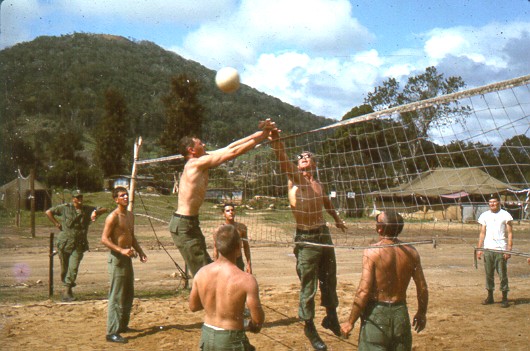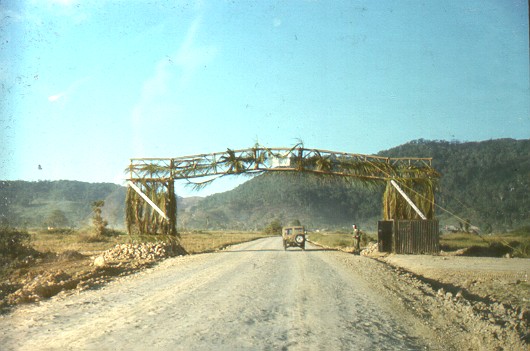
Hugh Savage's Memories
Page 2 of 5
On one trip I was escorting a crane when I got
mixed up shortly after getting off Route 19 just
west of An Khe. As I tried to find our way to
the bivouac site on narrow roads through rice
paddies, the crane slipped off into a paddy.
We tried to get the crane back on the road but
there was no way it was going to get out under
its own power and then my jeep got stuck. We
got the jeep out but only after getting covered
with rice paddy goo which was no doubt
liberally mixed with night soil (human feces). It was getting close to dark and we had no
idea if the local farmers were VC just waiting to pick off some hapless GI’s. We left a
guard with the crane. I found my way to the motor pool and, ignoring questions about
how I got so muddy or why I smelled so bad, asked Chief Applegate for a wrecker.
(Warrant Officer Applegate was the motor pool officer.) We got the crane out of the
paddy without any casualties other than my pride.
We moved in to the Golf Course ahead of any of the infantry in typical Combat Engineer
style. Again I was responsible for the perimeter defense. Everything was going
smoothly until I came to the S-4 (Supply) section. They had picked out a nice spot for
themselves that unfortunately was off the hilltop that were we defending and outside the
perimeter I had established. The Captain who was the S-4 said “Don’t worry about it,
we’ll take care of our selves.” I said, “yes Sir” and saluted as he outranked me. Earlier
that day a brigade of the 101st Airborne had just moved into our area and occupied a
neighboring hill. We were about a quarter of a mile outside of their perimeter. Shortly
after dusk fell the skies were lit with mortar flares and machine gun tracers. It was like
the Fourth of July, but it was September and no one was playing the Star Spangled
Banner. A lot of cows, pigs and banana trees got shot that night. I graciously allowed
the Captain and his section to crawl into the protection of our perimeter without
comment.
The night the 1st Air Cav moved in was another anxious time. They were keyed up and
trigger-happy. The term friendly fire took on an ominous meaning for me. My chances
of getting out alive seemed to be getting more remote. But things began to settle down to
a routine of 7 twelves (working 12 hours a day, seven days a week). The battalion moved
up to Engineer’s Hill which we shared with the 8th Engineers from the 1st Air Cav. We
had an Artillery Battery behind us. They frequently shot H&I (harassment and
interdiction) fire over our heads. They would fire at random times in random directions
at all hours of the day and night. After a while we did not even hear it. One day an
officer was up visiting from Saigon. I was showing him around the site when some H&I
rounds were fired. He jumped about 5 feet into the air and on the way down was looking
for the nearest foxhole. He could not understand why we were so unconcerned until I
explained the situation to him.

Setting up BOQ Tent on Engineer's Hill:
CWO's Hansen & Applegate (front)
LT's Bennett, Browning & Lowe (rear)
Engineer’s Hill was on the approach path to the
airstrip inside the Division perimeter. The
junior officers’ BOQ tent was near the summit
of the hill. I swear the tent sides flapped as the
birds whop-whop-whopped a few feet over our
tent poles. Often the first hint of an operation
in trouble would come from the intensity of
helicopter traffic. The other indicator came
from the commo section who monitored the
Division’s radio traffic. As the events in the Ia
Drang Valley unfolded we listened intently to
the radios.
When we first moved on to Engineer’s Hill we
had to clear the brush for our tents dislocating
the local animal life. I was in the company area
when I heard a soldier come flying out of his
tent, followed by a cobra. He grabbed an
entrenching tool and cut off the snake’s head.
At about 24 inches from end to end fully
extended, an entrenching tool is not nearly long
enough in my opinion. Especially when the snake measured at least 10 feet long. Green
bamboo snakes were also seen in the area. They were also known as “Mr. Two Step”;
the maximum distance traveled after being bit by one.
Our days were not all grimness, danger, long hours and hard work. One day a rumor
spread that there was going to be a race between a Skycrane (a large single rotor
helicopter) and a Chinook (a troop carrying helicopter with rotors forward and aft) from
Pleiku to the base camp. We watched the sky expectantly to see who would be first. As I
remember, the Skycrane won.
It seems helicopters were as common as jeeps and trucks. As pay officer for
Headquarters Company I would ride a Huey down to Qui Nhon and bring back the
payroll. After a few months our chopper and pilot (the least gung ho West Point graduate
I have ever meet) were taken away from us and I had to take a jeep. I was not happy
about the change. I had enjoyed riding the choppers. But more than that, I felt more
vulnerable in a jeep driving the dreaded Route 19 with $30,000 or so in greenbacks and
piasters. The presence of the ROK Army (Republic of Korea) at the bridges on the
piedmont made me feel a little more secure. They were tough, impressive looking
soldiers and it was rumored that the VC feared them.
A more enjoyable extra duty for me was PX Officer. The HQ Co Clerk, SP5 White, and
I set up an area PX in a couple of metal shipping containers with a tarp between them just
behind B Company. Initially we sold cigarettes and soap but eventually we got cameras
and stereos. Initially I bought an automatic 35mm camera which I upgraded toward the
end of my tour with single lens reflex 35 mm camera which I have to this day. I still
listen to the stereo I bought toward the end of my tour. We had regular hours in the
evenings but would open especially for an infantry outfit just coming in from the field.
One group in particular stays in my mind. I got to know their Lieutenant pretty well. We
shared many hopes and dreams. Like me he was considering going to seminary after the
army and getting married when he returned. It does not sound like much in common but
it did not take much. I have often wondered if he survived his tour and what happened to
him.
Weather permitting after lunch I played volleyball as often as possible. Regulars
included Doc Benjamin, the Battalion Medical Officer; 1LT. Richardson, our only
African-American Officer; 1LT. Mudarra, who took over HQ Company from CPT Fontes
when Fontes was promoted and transferred to Saigon; PFC Sinclair, PFC Jellinc, and
SGT Steuben. MAJ Bolton, the Battalion Executive Officer, would often come by and
watch.

Playing Volleyball on Engineer's Hill, AnKhe
I remember eating plentifully if
not well. Powdered eggs and milk
stand out in my memory as well as
occasional C rations. But what
really stands out were the times
we got fresh meat. Someone,
somehow procured a cow and we
had steak. That, and the first beer
rations were outstanding. On
some of our trips to Qui Nhon,
SP5 White would insist on eating
“on the economy”, i.e., local fare.
He was braver than I. I headed for
the nearest Army Mess Hall.
Often odors will bring back memories of Viet Nam, especially burned diesel fuel on a
dusty road. Once we learned to maintain a crown on the laterite roads they dried out
quickly and then had to be oiled so as not to become too dusty. But the most memorable
and ubiquitous smell was of excrement being burned with diesel oil.

Gate to Camp Radcliffe Decorated for Christmas 1965
Soon we had some amenities in
the BOQ such as power,
mosquito netting and wood
pallets to keep our boots out of
the mud at night. A constant
supply of pallets was necessary
because the termites ate them so
fast. And the mud became a
serious problem when the
monsoon began in November or
so. I have never seen it rain so
hard for so long before or since.
Just before leaving the States I
had bought some jump boots that
were the most comfortable shoes I have ever owned. Within a few months the laterite
mud and dampness destroyed them. About that time the better scroungers were began
wearing jungle boots. But a size 13 was too hard to find either within or outside of
channels so I had to settle for standard issue boots.
It did not take long for find what we needed in the local economy. An Khe became an
entrepreneurial hotbed. Things that could not be procured through the normal supply
channels showed up in the local black market; beer, cigarettes, jungle fatigues, combat
boots, etc. Immediately some cultural differences became apparent. For one, the
Vietnamese were used to haggling. When at first we automatically paid the price they
quoted us, we were stunned when the Vietnamese got angry and insulting. We had
spoiled their fun by not bargaining. We learned quickly but the good natured insults went
on. I made regular trips into An Khe to drop off and pick up my laundry. On one visit
with the First Sergeant of C Company a Vietnamese man came up to him, called him
“Komerade” and they shook hands warmly. They had become friends in Germany where
the Vietnamese was serving with the French Foreign
Legion.

Any time I walked around town I tended to attract a lot
of attention. At 6 foot, 7 inches tall, I towered over the
Vietnamese. The kids would giggle and ask me how
tall I was. I would hold up two fingers and say in my
best French, “Deux metre”. I became known as Dai
We 2 Metre (Lieutenant Two Meters) when they were
not calling me Dai We Number 10. (For some reason
number 1 was the best and number 10 the worst.)


To Go
Forward or Back Click on Arrows





